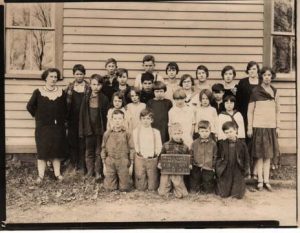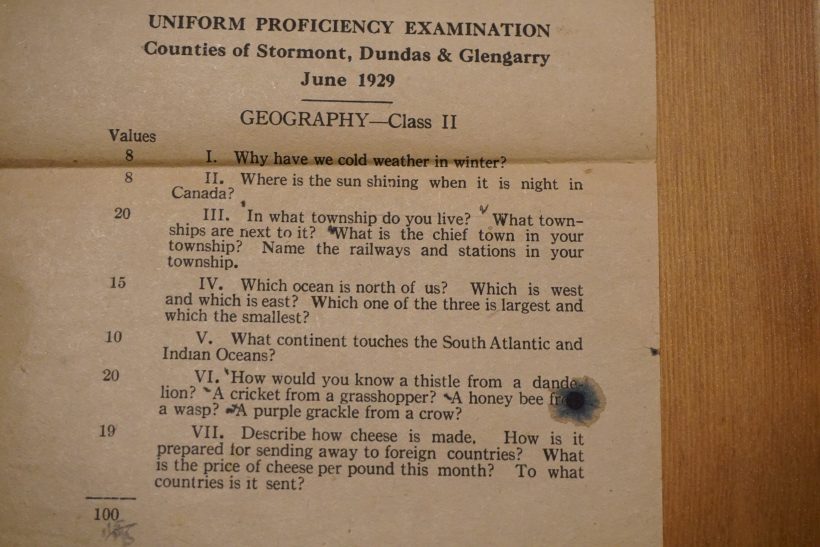SCHOOL EXAMS
June Examinations, 1922 LOWER SCHOOL ZOOLOGY
- (a) State two points of difference between (i) a spider and an insect, or between (ii) a butterfly and a moth.
(b) Name two harmful insects which infest orchard trees and two which infest garden vegetables. State the injury done by any two of them and the methods of combating their attacks.
- Write an account of the clam, under the following headings: –
(a) The breathing organs and the method of breathing.
(b) The foot and its adaptation to the conditions of life of the animal.
(c) Its foot and feeding habits.
- (a) Using drawings to illustrate your answer, describe the external features of the earthworm or the snail or the slug.
(b) Discuss the economic importance of either (i) earthworms, or (ii) frogs and toads.
- (a) Draw a side view of a common fish and name the parts represented.
(b) Show how the general shape of the body of the fish is adapted to its manner of life.
- (a) Write a description of the common frog or toad, under the following headlines: –
(i) The tongue.
(ii) The eyes.
- The fore limbs.
- The hind limbs.
- Describe the development of the frog or the toad from the egg to the adult form.
- (a) Name three winter birds and give the observations you have made on the
feeding habits of any one of them.
(b) Describe, using drawings, (i) the kinds of feathers, (ii) the bill, (iii) the foot, of any common bird you have studied, and show how these structures are adapted to the life habits of the bird.
- Describe the skeleton of the rabbit or the cat, under the following headings:-
(a) The spinal column.
(b) The fore limb or the hind limb.
(c) The teeth.
- Give an account of the external coverings of any two of the following, and state how they are adapted to the protection of the animals: snake, turtle, crayfish.
UNIFORM PROFICIENCY EXAMINATIONS
Counties of Stormont, Dundas & Glengarry
June 1929
GEOGRAPHY – Class 11
Values
- Why have we cold weather in winter?
- Where is the sun shining when it is night in Canada?
- In what township do you live? What townships are next to it? What is the chief town in your township? Name the railways and stations in your township.
IV. Which ocean is north of us? Which is west and which is east? Which one of the three is largest and which is the smallest?
- What continent touches the South Atlantic and Indian Oceans?
VI. How would you know a thistle from a dandelion? A cricket from a grasshopper? A honey bee from a wasp? A purple grackle from a crow?
V11. Describe how cheese is made. How is it prepared for sending away to foreign countries? What is the price of cheese per pound this month? To what countries is it sent?
/100
TONGUE IN CHEEK circa 911 (September 11, 2001)
At New York’s Kennedy airport an individual, later discovered to be a public school teacher, was arrested trying to board a flight while in possession of a ruler, a protractor, a setsquare, a slide rule, and a calculator.
At a morning press conference Attorney General John Ashcroft said he believes the man is a member of the notorious Al-gebra Movement. He is being charged by the FBI with carrying weapons of math instruction.
“Al-gebra is a fearsome cult,” said Ashcroft. “They desire average solutions by means and extremes and sometimes go off on tangents in a search of absolute value. They use secret code names like “x and y” and refer to themselves as “unknowns”, but we have determined they belong to a common denominator of the axis of medieval with coordinates in every country. As the Greek philanderer Isosceles used to say, “There are 3 sides to every triangle.”
When asked to comment on the arrest President Bush said, “If God wanted us to have better weapons of math instruction He would have given us more fingers and toes. I am gratified that our government has given us a sine that is intent on protracting us from these math-dogs who are willing to disintegrate us with calculus disregard.” By Anon

School Class photo – This photo was taken, according to the slate tablet, on October 29, 1929, (aka “Black Tuesday”) the very day the U.S. stock market crashed ushering in the Depression era. Miss. G. Gunter is the teacher at S.S. No.8. The Ridge school near Coe Hill, Ontario. Photo courtesy of Layne Moore, The Ridge. I believe his father Gerald is the lad with the bow tie, to the left of the boy holding the slate. He lived directly across the road from the school.
